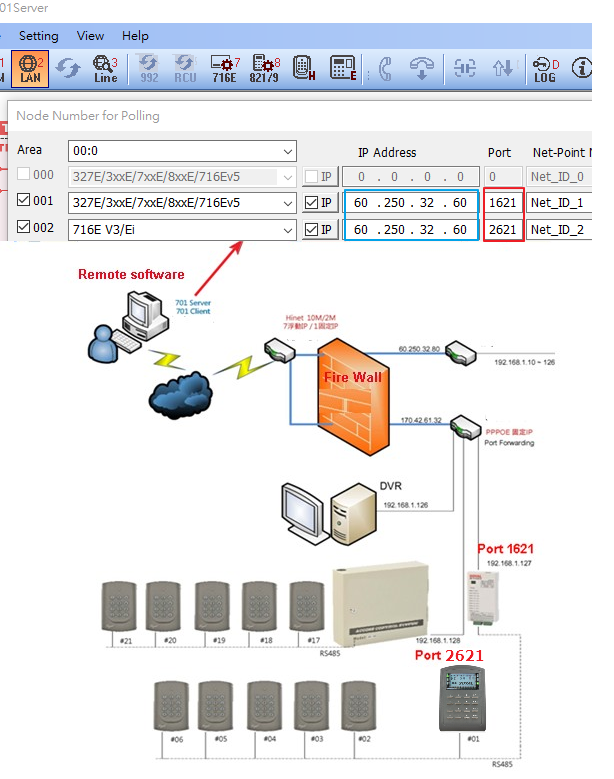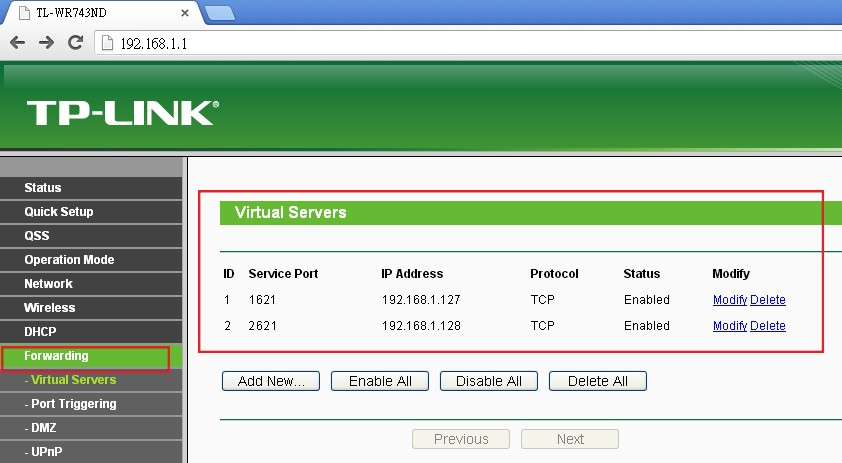For remote management, when the access control system’s hardware is connected via remote Internet connection, the application of NAT mode can be applied by single Internet IP address for many access controller units.
NAT (Network Address Translation) is a network application concept that allows a Router (broadband sharing device to receive and share data on computer network) on site to share an internet IP with multiple access controllers on the same network segment. NAT allows the ISP (Internet Service Provider) to set the NAT via on-site Router, allowing all access controllers on-site to be able to share a set of the same external Internet IP address.
Application: Installation of SOYAL access control in the branch office and installation of the 701 Software (701ServerSQL) in headquarter to receive data from branch office. The data transmission from branch office to headquarter is through external network. First, branch office on-site must register to either one of the options below:
1. Static IP Internet access: Internet access with a fixed IP allocated by the ISP
2. PPPoE for dial-up internet access, a virtual fixed IP set up is required to dial-up internet.
Secondly, to access the Internet, Router used by the branch office must enables Port Forwarding, also known as NAT or “virtual server” to allow external PC to connect to the on-site access controller through Internet-networked Router, through different TCP Port to differentiate connection to each access controller.
※In the 701 Software of 701ServerSQL installed at headquarter, the LAN Base Setting need to enter each branch office’s access controller IP address. If on-site have multiple access controllers, required to enter the on-site access controller’s IP controller of the corresponding designated TCP Port.
Example:
E Series controller wired directly to 701ServerSQL through RJ45, LAN Base Setting of Port is equivalent to Node ID + 6000.
| Node ID | Model No. | IP Address | Port |
| 001 | 327E/3xxE/7xxE/ 8xxE/716Ev5 | 192.168.1.101 | 6001 |
| 002 | 192.168.1.102 | 6002 | |
| 003 | 192.168.1.103 | 6003 |
H/E Series controller connected to 701ServerSQL through TCP to RS485 converter AR-727-CM/AR-401-IO-0808U2-R
| Converter | IP Address | Channel | Port |
| First unit of AR-727-CM | 192.168.1.200 | CH1 | 7001 |
| CH2 | 7002 | ||
| Second unit of AR-727-CM | 192.168.1.201 | CH1 | 7003 |
| CH2 | 7004 |
Example two unit of AR-721-H connected to 701ServerSQL via second unit of AR-727-CM CH1 and CH2, 701ServerSQL LAN Base setting:
| Node ID | Model No. | IP Address | Port |
| 001 | 101H/323D/321&888W /721/723/757 | 192.168.1.201 | 7003 |
| 002 | 192.168.1.201 | 7004 |
※Important notice:
On-site access controller or converter’s Gateway setting must be correctly set to specified IP Address of the Internet-networked Router.
This is the only way to have the correct connection.

Scenario: Installing SOYAL access control devices in different branch offices, with the 701 software installed in the headquarters to retrieve data.
The branch offices need to transmit data to the 701 software in the headquarters through an external network.
Firstly, the branch offices need to apply for a fixed external network WAN IP address.
Secondly, the routers in the branch offices must enable TCP port forwarding to allow external computers to connect to the access control devices under the routers. Each access control device must be configured with a different port number to correspond to its respective IP address.
Please refer to the architecture diagram below: The first device uses Port 1621, the second device uses Port 2621, the third device uses Port 3621, the fourth device uses Port 4621, and so on.
In the configuration interface of the 701 software in the headquarters, the fixed external network WAN IP address needs to be entered, followed by entering different port numbers in sequence to differentiate each device.

